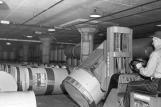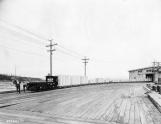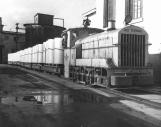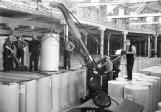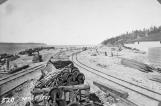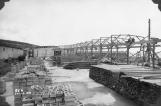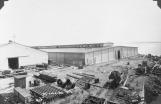15
The following information, found in a general description of the Powell River Mill, might well lead readers to believe the printers had erroneously inserted a portion of a railroad report:Track mileage, 10
Rolling stock, 363 cars
Types: Flat, sawdust, trash, side dump and work.
Locomotives, 6.
Actually such a report is not out of place. Powell River has a railroad. The small gauge system used in and around the paper mill to transport the rolls of newsprint, pulp, machinery and other equipment is an integral and impressive factor in plant transportation.
Powell River Digester
Vol 26, No. 4
July-August, 1950
17
In 1950 the paper mill small-gauge railroad had 10 miles of track, 363 cars and 6 locomotives. The flat cars included regular flats, sawdust cars, trash cars, side dump cars and work cars. The Railroad Maintenance Department, called "Car Shop," employed two experienced men to keep the cars in condition and completely rebuild them when necessary. The cars were 5 feet wide and 14 feet long and carried an average load of six tons of newsprint rolls.Wear and tear on the cars was rapid and the shop repaired an average of 20 per month. The side dump cars used for carrying lime rock from the wharf to the bunkers suffered the most wear. The bodies of these cars were of wood and iron, requiring metal-working skill on the part of the repair crew. The Car Shop also maintained dozens of two-and three-wheeled paper trucks used for storing paper in the holds of ships.
Powell River Digester
Vol. 26, No. 4
July-August 1950
19
Dock and Storage CrewsThese crews take charge of the output of the mill as it leaves the finishing room and store it in the paper warehouses or on the wharves until it is required for shipping. They also receive all incoming freight and ship all outgoing.
Powell River Digester,
Vol. 4, No. 5
May, 1925
21
April 19, 1927. The site of the new paper storage warehouse to be constructed at the Powell River Mill.-----
During the period 1910-1914, the paper storage was a long narrow building located alongside the groundwood mill, its dimensions were 505' by 45'. The only major item of equipment installed here was a Sandy Hill 90" core machine.
During the First World War additional storage space was found necessary and a corrugated galvanized iron storage shed 500' by 77' was constructed.
Ever since the mill was first started a 30" narrow gauge railway has been used to transport paper and other commodities. Originally the cars were horse-drawn but later electric and diesel locomotives were used. This rail system is still in use although large areas throughout the mill yard have been paved and this system is now augmented by trucks, carriers, and lift trucks.
-----
1923-30 Development
As part of this development, in order to handle the increased production, a second deep sea wharf was erected. This was an all-timber wharf supported on creosoted piles. Main wharf was 325' by 129', on which was constructed a warehouse 87' by 304', equipped with a 12-ton marine elevator made by Colby Crane and Engineering. The main wharf is reached by an approach section 492' by 49'.
1928-1930
An additional concrete and brick warehouse was built as part of this development to handle the additional paper tonnage. This building was 158' by 363'.
1951 to 1952 Development
A new wharf and shore quay has been constructed. This development will accommodate two deep sea ships and three coastal ships or scows at one time. The original wharf has been demolished and the wharf constructed in 1925 has been converted to a bulk cargo wharf for handling sulphur, fuel oil, clay, hog fuel and other miscellaneous cargoes. The shore quay is 580' by 130'; the deep sea wharf is 480' by 180'. Both sections are constructed by driving a sheet-steel pile bulkhead around the outside and filling with earth. The entire surface is asphalt paved. Steel - frame, corrugated - asbestos siding, warehouses are constructed on both wharves. Three 12-ton Colby Crane and Engineering Company marine elevators are located on the shore quay.
Canadian Pulp and Paper Industry
Vol. 5, No. 7
July, 1952
